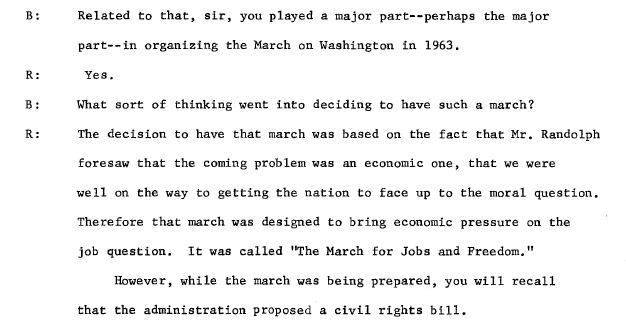Bayard Rustin Oral History, excerpt

Date: 1969
Caption: This oral history, housed at the LBJ Presidential Library, highlights Bayard Rustin’s civil rights work throughout his life. This excerpt emphasizes his work organizing alongside A. Philip Randolph in 1941 and 1963.
Bayard Rustin was born in West Chester, Pennsylvania, on March 12, 1912. He was raised by his maternal grandmother, who was an active member of the National Association for the Advancement of Colored People (NAACP). Because of her activism, Bayard engaged in protests against racial discrimination at a very young age. After spending time at Wilberforce College and Cheyney State Teachers College, Rustin moved to New York City in 1937. He began attending classes at City College and he became part of a radical network of activists and organizers. Through this network, he met and worked alongside Ella Baker, A. Philip Randolph, and others. Randolph quickly noticed Rustin’s talent for organizing demonstrations. In 1941, Randolph enlisted Rustin to organize a demonstration at the United States Capitol against segregation in the armed forces and racial discrimination in employment. The pressure from this proposed march compelled President Franklin Delano Roosevelt to sign an executive order that prohibited racial and ethnic discrimination in the nation’s defense industry, which was very active as World War II was underway.
Rustin continued to organize and participate in demonstrations. Rustin was one of the organizers of the first planned Freedom Ride in 1947 to challenge racial discrimination in interstate travel. He later became a trusted advisor of Dr. Martin Luther King, Jr., helped organize the Southern Christian Leadership Conference (SCLC), and helped in the formation of the Student Nonviolent Coordinating Committee.
A. Philip Randolph called again on Rustin’s organizing skills to prepare the 1963 March on Washington for Jobs and Freedom, where Dr. King gave his “I Have a Dream" speech. Rustin worked across the nation to organize the demonstration in which more than 200,000 people took part. When asked by an interviewer about the “most interesting people” to participate in the march, Rustin acknowledged that celebrities’ participation drew attention, but, in his view, “they were not the important people. The important people were those people who hitchhiked, who came on crutches, who came in ramshackle automobiles, who walked, because that was the mass. They were the voice. And that’s what the President of the United States and the Congress saw.”
Despite the respect that movement organizers and participants had for Rustin, he often worked behind the scenes. Rustin was an openly gay man who had also briefly been a member of the Communist Party. Leaders within the movement worried that those opposed to the burgeoning civil rights movement would exploit widespread homophobia to discredit the movement.
Categories: national
Tags: organizing, protest, racist segregation, queer people, Disabled people, physical disabilities, communism
This item is part of "Before the Boycotts: Organizing and Direct Action" in "Boycotting New York’s Segregated Schools"
Item Details
Date: 1969
Creator: Bayard Rustin
Source: Lyndon Baines Johnson Presidential Library
Copyright: Public domain. Courtesy of the Lyndon Baines Johnson Presidential Library.
How to cite: “Bayard Rustin Oral History, excerpt,” Bayard Rustin, in New York City Civil Rights History Project, Accessed: [Month Day, Year], https://nyccivilrightshistory.org/gallery/bayard-rustin.
Questions to Consider
- In this interview, Bayard Rustin discussed why A. Philip Randolph counted on him as an organizer. What reasons did Rustin give for Randolph’s trust in him? What were the organizing tasks that Rustin completed?
- How did Bayard Rustin’s work align with the political framework of A. Philip Randolph?
- How do you think Bayard Rustin felt working in movements that acknowledged his organizing genius while also asking him to stay behind the scenes because of his sexuality?
References
How to Print this Page
- Press Ctrl + P or Cmd + P to open the print dialogue window.
- Under settings, choose "display headers and footers" if you want to print page numbers and the web address.
- Embedded PDF files will not print as part of the page. For best printing results, download the PDF and print from Adobe Reader or Preview.
